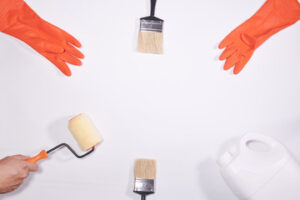Painters West Chester PA apply paint and other decorative finishes to structures, walls, and equipment. They may also prepare surfaces, such as scraping and removing wallpaper.
Successful artists are willing to take risks with their work. They understand that happy accidents can lead to beautiful results, even if they were not initially well planned.

Painting is an art form that combines various colors and textures to create expressive patterns on a flat surface. Artists use this two-dimensional visual language to represent real or supernatural phenomena, interpret a narrative theme, or build wholly abstract visual relationships. The most basic form of painting is applying wet mediums like oil paint or watercolor to a canvas. Artists can experiment with this technique to develop their unique artistic style.
The practice of painting has been around since prehistoric times. Historians, philosophers, and anthropologists study our ancestors’ paintings to understand what they were trying to convey. The best-known paintings include Leonardo da Vinci’s Mona Lisa, Edvard Munch’s The Scream, and Vincent van Gogh’s Starry Night. These pieces are powerful because they transcend perception and reach the emotional, psychological, and even spiritual levels of the human experience.
To create a painting, an artist must select their canvas and color scheme, brush size and type, and choose a subject. Then, they must start putting paint onto the canvas or paper, working in layers. For example, a base layer of dark paint (like burnt sienna or phthalo blue) is applied to the surface before adding more detailed layers. The final piece is then finished with a coat of varnish or a protective layer of clear coat that helps preserve the painting.
Artists must be willing to let go and not worry about the final product during the painting process. Some painters are more comfortable using “process painting,” where the experience is more important than the outcome. This is a great way for beginners to get creative without fearing failure.
Many painters will also play music while painting, as it can raise their spirits and influence their work. Some painters will even try to “paint in time” with the music they are listening to. Other techniques used in conjunction with painting include collage and stippling. Collage uses pieces of paper, such as newspapers, magazines, photographs, and wrapping paper, to create a design on the canvas or wall. This technique can add texture to the work and is a great way for novice painters to try different designs. Stippling involves using a small brush to create dots or speckles on the surface of the work.
Sculpture is the art form in which hard or plastic materials are worked into three-dimensional art objects. Sculptures may be freestanding or in reliefs attached to surfaces or in environments that envelop the viewer. The variety of materials and techniques used by sculptors is enormous.
In the past, the most common material for sculpture was stone. It is relatively durable and can be carved into fine detail with various tools. Stone was used for cult images and architectural pieces such as temples, palaces, and tombs. Stone carving was a skilled craft, and master carvers were considered artists of the highest status in society.
Wood was a popular medium for smaller sculptures that could be painted. However, it wears less well than stone, and the color fades over time. Therefore, it was often covered in a layer of gesso or plaster before the sculpture was finished. Eventually, a layer of polychrome was added, enhancing the work’s beauty and durability.
Bronze was another popular sculpture material, and it has been used for figures of all sizes from antiquity to modern times. Like carved stone, it can be very detailed and has the advantage of being light. Bronze can also be cast, allowing the artist to reproduce more complex shapes and more details in the artwork.
The most recent developments in sculptural technique involve using metals and plastics. These are usually combined with other materials such as glass, clay, rubber, plaster, wire, and found objects. These “mixed media” sculptural works can be called hybrids.
Sculpture is traditionally divided into two categories: sculpture “in the round,” which is freestanding and has no attachment to another surface, and sculpture in relief, which projects out from or into a background. The degree of projection is usually categorized as low relief, bas relief, high relief, or sunk relief. Depending on the type of design, relief may be either positive or negative. The artist can create a negative shape by carving away the background or a positive shape by modeling or casting on an armature.
Printmaking is one of the oldest and most enduring forms of artistic expression. Its unique value as an art form lies in allowing artists to reproduce a design, image, or text on an infinite number of copies – which can be purchased by a much wider audience than a single painting could ever reach. The medium’s history is steeped in incredible craftsmanship and technical skill, as it has allowed for the production of images that are incredibly detailed and visually evocative.
Early prints spread information, texts, and religious imagery worldwide. The craft became even more significant in the fifteenth century when artists such as Albrecht Durer and Rembrandt embraced and took the art of printing to new heights. This period also saw the rise of Japanese artist Katsushika Hokusai, who brought woodblock printing to a new level of subtlety and beauty.
Traditional printmaking is divided into two main categories: relief and intaglio. The latter involves creating an image on a metal matrix by engraving it or chemically etching it into the surface. When inked and pressed against paper, the image is transferred from the inked matrix to the paper, leaving only the carved lines – a technique that allows for extremely detailed images.
Some printmaking techniques combine elements of relief and intaglio, such as collagraph, a method where the artist creates an image by adding collaged materials to a plate and then inking and pressing it onto paper. This gives the print a textured look.
There is also the monotype, a one-off print that can only be created by drawing ink on a Perspex, metal, or card plate and then transferring the inked impression to a piece of paper with a tool like the back of a spoon or baren. This technique is often called the most painterly of the various printmaking methods. It was favored by Edgar Degas and Jean Dubuffet, known for their spontaneity and fluidity of marks.
Drawing is a fundamental creative art that is often considered the foundation of other art forms. Whether used to prepare for painting or sculpting, a good drawing is critical for creating an exquisite work of art.
Like other visual arts, drawing has undergone a great evolution throughout history. Each new style grew out of the one that came before it, and these trends often coincide with the materials available to artists of each era.
While some drawings have been created without using any media, such as sand or clay, others were made with dry materials like chalk, charcoal, pencil, graphite, and oil pastel. In addition, many modern works of art are drawn using a computer or other digital devices. While these digital tools can be useful, learning to draw traditionally is a valuable skill for anyone who wants to become an artist.
Throughout art history, drawing has been closely linked to observation and problem-solving. It is often viewed as an essential precursor to other artistic mediums and is used to test compositions or arrangements before committing to a painting or sculpture. Historically, most paintings and sculptures have been preceded by preliminary sketches in drawings. These sketches can also be used to solve specific observational and technical issues.
A basic drawing is often composed of short straight lines and overlapping contours, or “guidelines,” that are lightly sketched to outline the shape of an object. This skeleton drawing can then be refined to achieve the desired look and feel of the finished piece. During this process, it is important to remember the effects of light on objects and how shadows are cast or lifted depending on where they fall.
For example, if you are drawing a zebra, it is helpful to remove negative space (lines that do not make sense to the logical left side of your brain) first so that when you copy this onto your painting surface, the shape of the zebra will appear automatically. It is also good to mark areas of high or low value on your drawing with a dotted or solid line to accurately place values when you paint.
